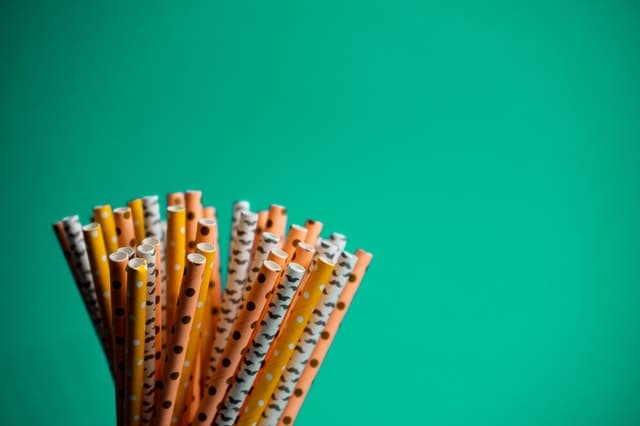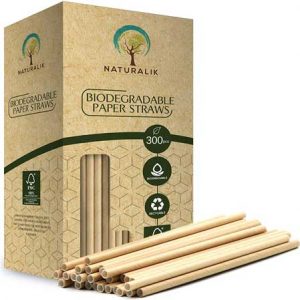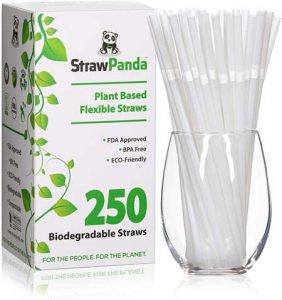Biodegradable drinking straws are an excellent method of protecting the environment and a good alternative to regular plastic straws that reach the landfills and oceans of the planet every day. With tens of thousands of straws used on a daily basis around the planet, switching to the biodegradable straw alternative is essential for cutting the amount of waste plastics and pollution.
What Are Biodegradable Drinking Straws?
Drinking straws have an impressively long history, dating back five millennials ago, in a time when Sumerians used them in the form of gold tubes inlaid with blue stone to filter out the fermented particles in their beer. Natural straws made from metal and rye grass continued to be used until 1888, when a spiral winding system was patented and used to manufacture paper straws.
Paper straws had layer of paraffin coating them and preventing the paper from getting soggy. Their width was small enough to stop lemon seeds from getting trapped inside and they started to gain more popularity over the years, eventually turning into the forerunner the plastic straws we use today.
Drinking straws in general are recommended by dentists as means of pulling sugary drinks into the mouth without risking to damage the enamel on the teeth. They are also considered to be more sanitary when it comes to drinking liquids when compared to the use of drinking glasses with dirty rims. Biodegradable drinking straws are not only good for your oral health, but they are also the best alternative to plastic straws as they do a good job at keeping the planet safe from this particular type of waste plastics.
Biodegradable Drinking Straws 101
At the moment, there are several different types of biodegradable straws available for use on the market. The great majority of them can be used a single time and they are found in different sizes. Most biodegradable straws are used for drinking cold drinks, with a few exceptions that can also withstand hot beverages. Some ecofriendly straws also play the role of coffee stirrers. If you are eager to find out what are biodegradable straws made of, keep reading.
Biodegradable Paper Straws
The paper straw based on the original 1888 straw model is still considered to be the best biodegradable option on the market even today. It is not only manufactured at affordable costs, but it is also safe to use and carried FSC certifications and FDA’s seal of approval. Plus, a paper straw can also be printed using inks that are safe to use around food.
As a drawback, a paper straw is not commonly used when serving a hot beverage, and it is usually limited to use for cold drinks.
Biodegradable Straws Made of Hay or Wheat
Hay straws, wheat straws and straws made from other types of grass in general are also an excellent alternative to plastic straws. They are 100% natural and manufactured with the help of gluten-free wheat stems and they are commonly used for producing drinking straws that are 7 ¾” in size, as well as cocktail straws that are 5″ in size. The fact that hay is free of harmful chemicals, 100% biodegradable, and can be currently grown in the form of sustainable crops makes these straws highly appreciated on the market.
As a side note, consumers who suffer from grass, hay, or grass allergies in general will risk triggering an allergic reaction when using these straws. Plus, hay straws are best used for serving cold drinks only. There is also the risk of the occasional breakage and splitting of these straws.
Biodegradable Straws Made Of Bamboo
Bamboo straws are usually reusable, this leading to buying costs. They can also be used for serving cold and hot drinks alike and they are manufactured with the help of sustainable materials made of natural plants. Biodegradable straws manufacturers who produce bamboo straws can produce them at different diameters and lengths. These straws are also compostable and they require washing after each use, which may not appeal to some people.
Biodegradable Straws Made Of Plastic
These straws are also called PLA straws and they are manufactured with the help of oil and plant starch such as corn. This means they can normally decompose in a natural manner in commercial compost facilities, usually in two up to six months at times, and they are just as sturdy regular plastic straws. Mass production is also possible for these straws. Disposing of these straws is not possible in a compost heap, and specialized composting facilities must be used instead.
Glass straws made of borosilicate for enhanced anti-breaking and anti-shattering properties can be used for serving both cold and hot beverages. However, their main drawback is that they absorb and retain cold and hot temperatures, especially when it comes to bent straws. Plus, some consumers also complain about the metal aftertaste they experience after using these straws.
Final Thoughts
Biodegradable drinking straws are a good way of promoting the use of eco-friendly products, while keeping toxic substances out of the planet’s landfills and oceans. While these straws might not sound too important to take into account in the global plastic waste problem, any solution that could help us move into the right direction should be embraced. Redirect your attention to biodegradable, compostable, and reusable drinking straws made of paper or plants and continue your zero-waste journey as a consumer.


![Paper-Drinking-Straws-[200-Pack]-100%-Biodegradable---Assorted-Colors](https://www.eco-friendly.website/wp-content/uploads/2021/05/Paper-Drinking-Straws-200-Pack-100-Biodegradable-Assorted-Colors-300x267.jpg)

